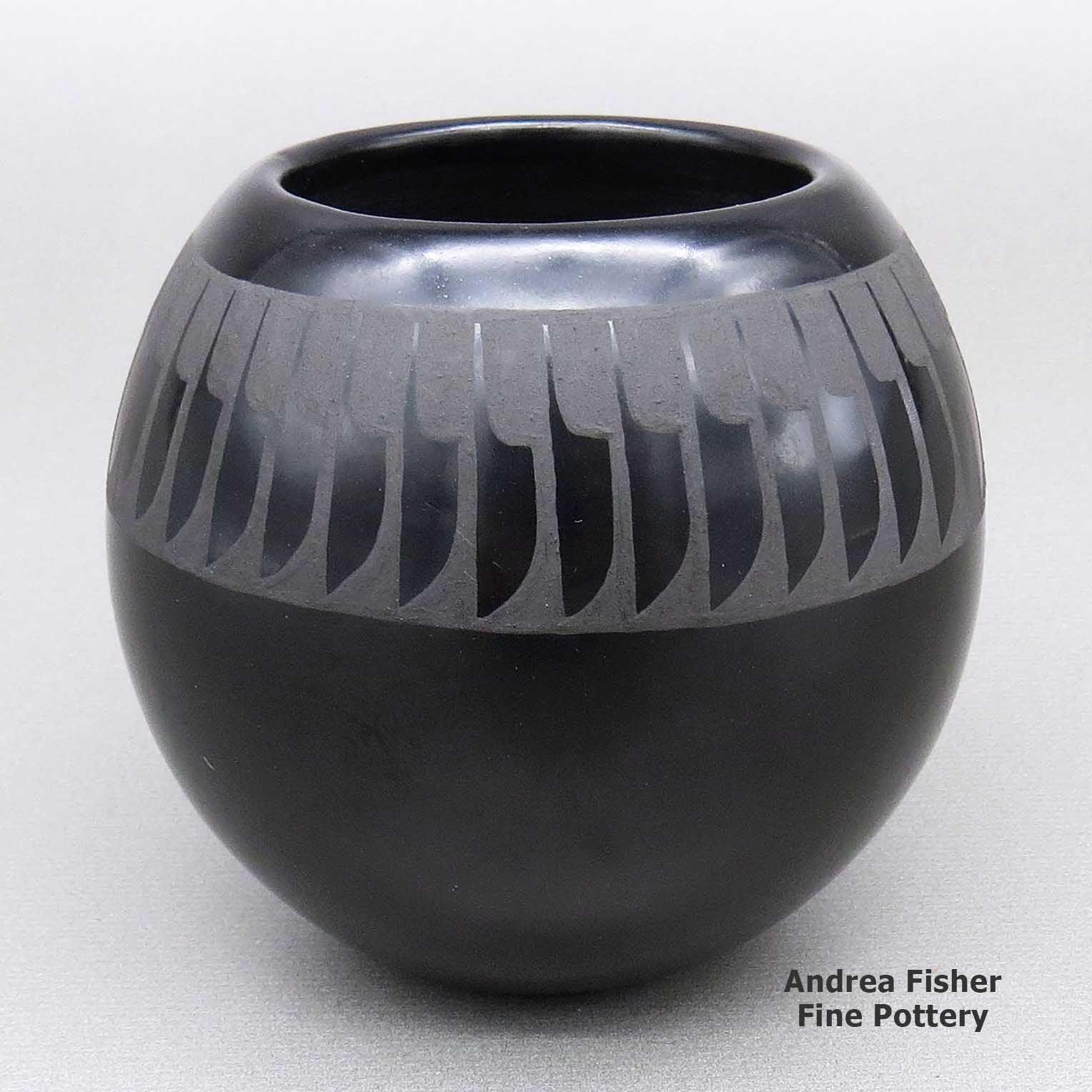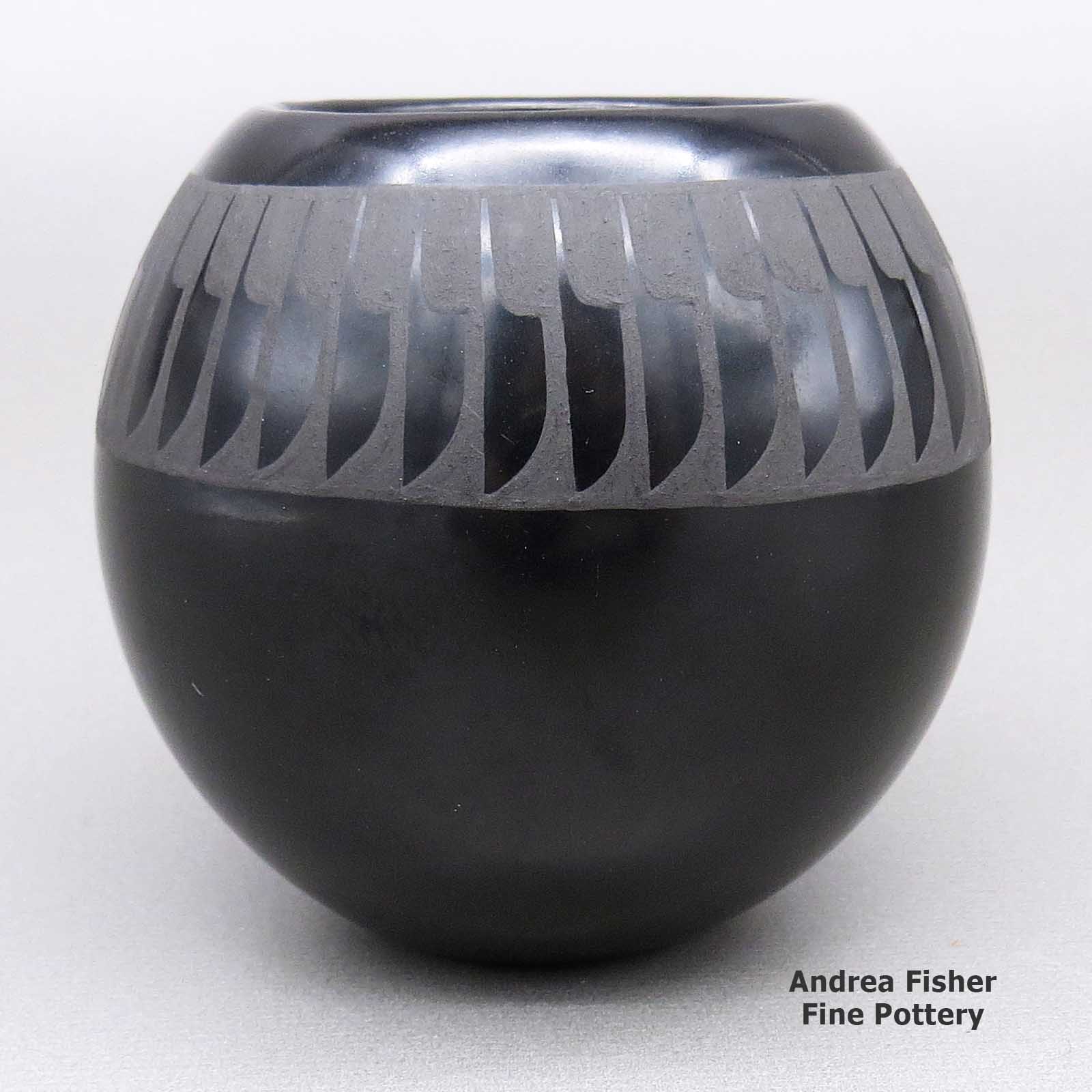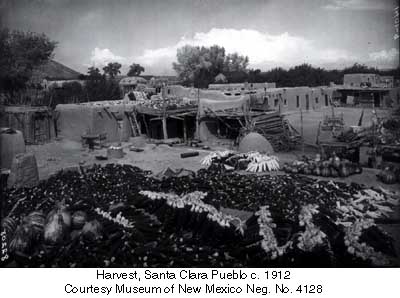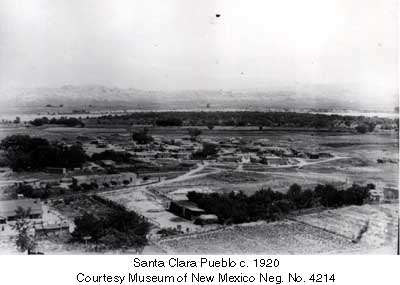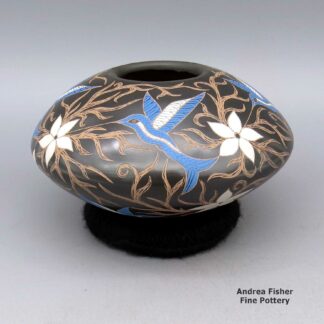| Dimensions | 3 × 3 × 3 in |
|---|---|
| Condition of Piece | Very good, has sticker residue on bottom |
| Date Born | 1986 |
| Signature | Denny Santa Clara |
Denny Gutierrez, zzsc3b270, Black bowl with a geometric design
$495.00
A black-on-black bowl decorated with a ring-of-feathers geometric design
In stock
Brand
Gutierrez, Denny
A Short History of Santa Clara Pueblo

Santa Clara Pueblo straddles the Rio Grande about 25 miles north of Santa Fe. Of all the pueblos, Santa Clara has the largest number of potters.
The ancestral roots of the Santa Clara people have been traced to ancient pueblos in the Mesa Verde region in southwestern Colorado. When the weather in that area began to get dry between about 1100 and 1300 CE, some of the people migrated to the Chama River Valley and constructed Poshuouinge (about 3 miles south of what is now Abiquiu on the edge of the mesa above the Chama River). Eventually reaching two and three stories high with up to 700 rooms on the ground floor, Poshuouinge was inhabited from about 1375 CE to about 1475 CE.
Drought then again forced the people to move. One group of the people went to the area of Puyé (along Santa Clara Canyon, cut into the eastern slopes of the Pajarito Plateau of the Jemez Mountains). Another group went south of there to what we now call Tsankawi. A third group went a bit to the north, following the Rio Chama down to where it met the Rio Grande and founded Ohkay Owingeh on the northwest side of that confluence.
Beginning around 1580, another drought forced the residents of the Puyé area to relocate closer to the Rio Grande. There, near the point where Santa Clara Creek merged into the Rio Grande, they founded what we now know as Santa Clara Pueblo. Ohkay Owingeh was to the north on the other side of the Rio Chama. That same dry spell forced the people down the hill from Tsankawi to the Rio Grande where they founded San Ildefonso Pueblo to the south of Santa Clara, on the other side of Black Mesa.
In 1598 Spanish colonists from nearby Yunqué (the seat of Spanish government near the renamed "San Juan de los Caballeros" Pueblo) brought the first missionaries to Santa Clara. That led to the first mission church being built around 1622. However, the Santa Clarans chafed under the weight of Spanish rule like the other pueblos did and were in the forefront of the Pueblo Revolt of 1680. One pueblo resident, a mixed black and Tewa man named Domingo Naranjo, was one of the rebellion's ringleaders.
When Don Diego de Vargas came back to the area in 1694, he found most of the Santa Clarans were set up on top of nearby Black Mesa (with the people of San Ildefonso, Pojoaque, Tesuque and Nambé). An extended siege didn't subdue them but eventually, the two sides negotiated a treaty and the people returned to their pueblos. However, successive invasions and occupations by northern Europeans took their toll on the pueblos over the next 250 years. The Spanish flu pandemic in 1918 almost wiped them out.
Today, Santa Clara Pueblo is home to as many as 2,600 people and they comprise probably the largest per capita number of artists of any North American tribe (estimates of the number of potters run as high as 1-in-4 residents).
For more info:Pueblos of the Rio Grande, Daniel Gibson, ISBN-13:978-1-887896-26-9, Rio Nuevo Publishers, 2001
Upper photo courtesy of Einar Kvaran, Creative Commons Attribution-Share Alike 3.0 Unported License
About Bowls
The bowl is a basic utilitarian shape, a round container more wide than deep with a rim that is easy to pour or sip from without spilling the contents. A jar, on the other hand, tends to be more tall and less wide with a smaller opening. That makes the jar better for cooking or storage than for eating from. Among the Ancestral Puebloans both shapes were among their most common forms of pottery.
Most folks ate their meals as a broth with beans, squash, corn, whatever else might be in season and whatever meat was available. The whole village (or maybe just the family) might cook in common in a large ceramic jar, then serve the people in their individual bowls.
Bowls were such a central part of life back then that the people of the Classic Mimbres society even buried their dead with their individual bowls placed over their faces, with a "kill hole" in the bottom to let the spirit escape. Those bowls were almost always decorated on the interior (mostly black-on-white, color came into use a couple generations before the collapse of their society and abandonment of the area). They were seldom decorated on the exterior.
It has been conjectured that when the great migrations of the 11th, 12th, 13th and 14th centuries were happening, old societal structures had to change and communal feasting grew as a means to meet, greet, mingle with and merge newly arrived immigrants into an already established village. That process called for larger cooking vessels, larger serving vessels and larger eating bowls. It also brought about a convergence of techniques, styles, decorations and design palettes as the people in each locality adapted. Or didn't: the people in the Gallina Highlands were notorious for their refusal to adapt and modernize for several hundred years. They even enforced a No Man's Land between their territory and that of the Great Houses of Chaco Canyon, killing any and all foreign intruders. Eventually, they seem to have merged with the Towa as those people migrated from the Four Corners area to the southern Jemez Mountains.
Traditional bowls lost that societal importance when mass-produced cookware and dishware appeared. But, like most other Native American pottery in the last 150 years, market forces caused them to morph into artwork.
Bowls also have other uses. The Zias and the Santo Domingos are known for their large dough bowls, serving bowls, hair-washing bowls and smaller chili bowls. Historically, these utilitarian bowls have been decorated on their exteriors. More recently, they've been getting decorated on the interior, too.
The bowl has also morphed into other forms, like Marilyn Ray's Friendship Bowls with children, puppies, birds, lizards and turtles playing on and in them. Or Betty Manygoats' bowls encrusted with appliqués of horned toads or Reynaldo Quezada's large, glossy black corrugated bowls with custom ceramic black stands.
When it comes to low-shouldered but wide circumference ceramic pieces (such as many Sikyátki-Revival and Hawikuh-Revival pieces are), are those jars or bowls? Conjecture is that the shape allows two hands to hold the piece securely by the solid body while tipping it up to sip or eat from the narrower opening. That narrower opening, though, is what makes it a jar. The decorations on it indicate that it is more likely a serving vessel than a cooking vessel.
This is where our hindsight gets fuzzy. In the days of Sikyátki, those potters used lignite coal to fire their pieces. That coal made a hotter fire than wood or manure (which wasn't available until the Spanish brought it). That hotter fire required different formulations of temper-to-clay and mineral paints. Those pieces were perhaps more solid and liquid resistant than most modern Hopi pottery is: many Sikyátki pieces survived intact after being slowly buried in the sand and exposed to the desert elements for hundreds of years. Many others were broken but were relatively easy to reassemble as their constituent pieces were found all in one spot and they survived the elements. Today's pottery, made the traditional way, wouldn't survive like that. But that ancient pottery might have been solid enough to be used for cooking purposes, back in the day.
About Bird Elements
One of the main tenets of the Flower World ideology is that birds are messengers to and from Paradise. They carry our prayers to Heaven and they bring back the responses. Not all the pueblos accepted the Flower World ideology but it seems almost everyone, almost everywhere, agrees that birds are the messengers of Heaven. All pueblos do have multiple designs that incorporate feathers, if feathers aren't the main element of the design.
The Flower World ideology originated in central Mexico and most likely traveled north to the pueblos in the company of missionaries and long-distance traders. Turquoise was taken south while tropical birds, copper bells, seashells, and textiles (with particular spiritual designs on them), along with other spiritual items, were taken north. Going either way, almost everyone passed by Paquimé. The trade routes from the south came together there and the trade routes to the north diverged from there. That business didn't really come together until the first structures went up in the immediate vicinity of Paquimé, around 1150 CE. Then it ended around 1450 CE when the city was abandoned. That was also the end of pilgrims making their way south and then coming north again a few years later. For more than 300 years that traffic had been a major profit center and prestige generator for the people of Paquimé and Casas Grandes. After Paquimé was abandoned, though, the trade and pilrimage routes became far more dangerous. With the advent of the Aztec Empire in central Mexico, being a foreigner in that area became far more dangerous, too. Essentially, the puebloans who had embraced the Flower World ideology were cut off from their Holy Land.
The Flower World Complex, with its symbology, flowed across the American Southwest and eventually reached the Four Corners area. But it arrived at about the same time the kachina cults were coming together and the people were abandoning the Four Corners. The Flower World ideology was felt to be greater than what had come before so it's symbology was basically imprinted on top of that. Then the designs of the kachina cults and other clans were added on top of the Flower World symbology. Then came the Europeans with their designs and spiritual practices.
One of the principals of Native American design is that it is necessary only to note one part of most animals to imply the presence of the whole, especially when it comes to birds and bird elements. A lot of the design on Hopi pottery can only be described as "bird elements," although it is often possible to discern parrot feathers from eagle feathers, and eagletails from other bird's tails.
The Zunis have an ancient "almost-spiral" design that comes from the beaks of their equally ancient "rainbirds." The Zunis also like to make owl figures as owls are a symbol of wisdom to them. To some Northern Tewas, owls are creatures to be feared.
At Acoma they have a "cloudeater," a crane pictured with neck bent over and filling with fish shown sideways in its throat as it swallows them whole. Acoma potters also have a parrot that resembles the parrot found on the sides of the boxes carried by Amish traders back in the day. The parrot is not complete without a branch with leaves, and maybe berries, in its claws.
At Santo Domingo, religious dictates limit what can be imaged on pottery offered to the public. Birds, fish, turtles and flowers are allowed, along with a vast catalog of geometric designs. Images of humans are not. Next door at Cochiti, almost anything goes
The artists of the Mata Ortiz area are resurrecting some of the designs left behind by artists of old but they have no inner connection with the Flower World. Others in today's Mata Ortiz have gone totally contemporary: carving, scratching and painting beautiful images of birds with branches, vines and flowers.
